Cylinder Oil
-
- Optimizing Feed Rates For Crosshead Diesels Maritime Reporter, Nov 2003 #88
New program analyzes scrapedown oil as way to detect changes in the condition of an engine's cylinders ExxonMobil introduced a program to optimize cylinder oil feed rates in low-speed (crosshead) diesel engines. The "Feed Rate Optimization" program is designed to help minimize operating expenses by analyzing scrapedown oil as a way to detect changes in the condition of an engine's cylinders. The program, which is designed to help customers find a balance between the cost of cylinder oil and the expense of wear-related cylinder maintenance, analyzes scrapedown oil collected from the engine's scavenge space, a technique pioneered by ExxonMobil. It is designed to provide comprehensive laboratory testing and analysis of the oil sample, and offers onboard testing tools that enable ship's engineers to quickly detect substantive changes in cylinder condition.
The new program features: • Signum Oil Analysis: ExxonMobil has extended its existing Signum Oil Analysis program, which can help forecast potential mechanical problems before they occur, to include scrapedown testing. This extensive laboratory analysis provides insight into engine wear via the condition of a vessel's scrapedown oil.
• Onboard testing: Onboard testing tools include a proprietary Mobilgard Scrapedown Analyzer (pictured), a portable unit that enables a ship's engineer to quickly analyze the current wear rate of each cylinder.
For customers who do not want to wait for a comprehensive lab report, onboard testing provides real-time readouts on the oil's most important properties relativ e to the engine's operating condition.
• Quality oil: ExxonMobil recommends Mobilgard 570, a cylinder oil formulated at an optimized viscosity level with high quality base oil to provide excellent thermal and oxidation stability, and protection against engine deposit and wear. It is proven to provide lowspeed.
two-cycle crosshead diesel engines with these performance features even as lower feed rates are adopted.
The new Feed Rate Optimization program was developed with the support of the major engine manufacturers, including MAN B&W and Wlirtsila.
"Changes in cylinder wear due to engine operation, ambient conditions and fuel sulfur levels can be detected as they are occurring, particularly if onboard sample analysis is employed," says Kjeld E. Aabo, senior manager engineering services. MAN B&W Diesel A/S.
"Advanced warning of cylinder condition, as seen through scrapedown oil analysis results, allows the operator to optimize feed rates while ensuring optimum engine performance." Following are some answers to common questions regarding the new system.
Q: Why did ExxonMobil Marine Lubricants introduce a "Feed Rate Optimization" program?
A: The trend toward increased size and speed of general cargo ships and container vessels mandates the continued domination of this segment by low-speed (crosshead) diesel engines, which can burn less-expensive residual fuel oil more efficiently and reliably than can other types of engines. At the same time, manufacturers have changed their engines dramatically over the past 20 years, and the new higher output designs for greater efficiency hav e greatly increased stress on the cylinder oil. Reduced cylinder oil consumption rates made possible by new feed system designs hav e further stressed the oil.
Environmental regulations and variations in HFO (heavy fuel oil) characteristics around the world have resulted in increasing numbers of engines operating on low-sulfur-content HFO. This can result in sudden wear if feed rates and lubricant selection are not properly balanced. A program to safely optimize cylinder oil feed rates against these variables while monitoring the condition of the engine's cylinders can help ship owners find an acceptable balance between the cost of the cylinder oil and the expense of wear-related cylinder maintenance. Identifying that balance can reduce total operating costs.
Q: Why is analyzing scrapedown oil so important?
A: With the use of cylinder scrapedown oil analysis (the analysis involves various tests of used oil as a way to monitor the condition of the engine and the lubricant).
it is possible to reduce cylinder oil feed rates to provide the optimum balance of cylinder oil and engine component replacement cost. Shipboard personnel can monitor the condition of an engine's cylinders and detect changes as they occur.
Q: What kind of laboratory tests does ExxonMobil perform?
A: For many years. ExxonMobil has been using Signum Oil Analysis to help customers monitor the performance and condition of lubricants, engines and equipment. The Signum program has been expanded to include analv sis of scrapedown cylinder oil. A comprehensive slate of laboratory tests includes: Inductively Coupled Plasma Emission Spectroscopy (which monitors wear metals - including iron, a primary wear indicator, and phosphorus, an indicator of system oil contamination); Physical and/or Chemical Analysis (which measures the total base number, viscosity and water as indicators of oil degradation and contamination); Particle Quantifier (which monitors abrasive wear): and Ferrography (which helps identify wear type and cause). Oil samples are sent from shipboard to an ExxonMobil laboratory. The program automatically reports trends and compares variables such as iron, base number, load, fuel sulfur and humidity.
Findings can help identify wear indicators before problems occur. And they can be used to optimize cylinder oil feed rate, minimizing the overall cost of operations.
Q: What kind of testing can take place aboard ship?
A: The Feed Rate Optimization program includes an option for onboard testing that is particularly useful for customers who do not want to wait for a comprehensive lab report. ExxonMobil provides the onboard tools for ship personnel to test the most important properties relative to wear and optimizing feed rates. A Mobilgard Scrapedown Analyzer (MSA) instantly measures and displays the iron content of a used cylinder oil sample. A Signum Onboard Test Kit monitors lubricants for alkalinity retention (TBN). water contamination and changes in viscosity. A MSA Logbook enables crewmembers aboard ship to store results, graph trends and analyze relationships between variables.
The tools are designed to be easy to use.
Q: What is the advantage of onboard testing?
A: Speed is the primary advantage. Onboard testing augments and complements the more comprehensive Signum laboratory testing with supplementary reports that are especially useful because they provide key results in a matter of seconds. Speedy access to technical data means that shipboard personnel can make feed rate adjustment decisions quickly. If the testing equipment alerts a ship's engineer to substantive changes in cylinders, he can take immediate corrective action before any problems become serious. Speed in detecting changes is important because wear can occur rapidly in two-stroke engines.
Q: What was the involvement of major engine manufacturers?
A: The new program was developed after cooperative testing with the major engine manufacturers. Says Matthias Amoser. manager Tribology and Material Technology. Wartsila Switzerland. Ltd. "Our experience has shown that the analysis of scrapedown cylinder oil can provide many clues regarding the operation of the engine, the impact of varying fuel sulfur levels, the effect of feed rate, and also, can serv e as an early warning to potential undesirable wear situations. A frequent onboard analysis program supplemented by land-based laboratory analysis provides key information for monitoring piston running experience." Circle 6 0 on Reader Service Card
-
- Marine Lubricants: New Year, New Emission Rules Maritime Reporter, Dec 2014 #62
. Our recommendation for the majority of vessels is a 40BN lubricant with higher levels of dispersancy and detergency additives than in higher BN cylinder oils.. So far, we have been in discussion with many operators and they have already started training their crew to meet the challenges of the fuel change
-
- New Marine Cylinder Oil Launched Maritime Reporter, Jan 2014 #54
the engine running on fuel with a sulfur content from 2.5-3.1%. ExxonMobil Marine Fuels & Lubricants launched Mobilgard 5100, a specially formulated cylinder oil designed to mitigate the effects of cold corrosion in new design two-stroke marine engines operating on heavy fuel oil. Mobilgard 5100 joins Mobilgard
-
- Lukoil: Cylinder Oil to Reduce Wear, Consumption Maritime Reporter, Nov 2013 #52
, we have demonstrated the new oil’s performance capability on a variety of ship engines,” said Claussen. “As an example, the wear rate was improved and cylinder oil consumption reduced in a state-of-the-art MAN S80ME-C Mk 9.2.” (As published in the November 2013 edition of Maritime Reporter & Engineering
-
- Combat Cold Corrossion via Condition Monitoring Maritime Reporter, Jul 2014 #56
gases to form sulphuric acid, a corrosive element which damages the liner surface. The iron compounds formed by this process are then flushed into the cylinder oil, leading to excessive wear of the cylinder liner with the cost of a replacement at an average cost of up to $150,000. To benefit from the more
-
- Fuels, Lubricants & Green Marine Maritime Reporter, May 2018 #60
Technical Manager, Dr. Sara Lawrence, has said that the technical, commercial and regulatory variables in play when considering a shipowner’s optimum cylinder oil supply solution are continuing to rise. To overcome some of these challenges, the company last year introduced new two-stroke and four-stroke cylinder
-
- Interview: Chia Yoo Soon, Chevron Marine Lubricants Maritime Reporter, Jan 2018 #24
industry see new from Chevron in 2018? The key term here is partnership, as we work with our customers to monitor the lubricants, predominately on the cylinder oil side. We will help them to monitor their feed rate, a new service to help them optimize the overall cost of ownership of the lubricants. There will
-
- IMO 2020: The Future of Fuel Maritime Reporter, Apr 2017 #22
in April of last year with Fathom Maritime Intelligence on the market research and consultancy company’s report ‘The Impact of Regulation on Cylinder Oil Lubricant Selection’ which provided an overview of relevant legislation and regulations with respect to fuel sulfur content and SOx emissions. The
-
- Matson Monitors Cylinder Liner Wear Maritime Reporter, May 2015 #66
and testing costs, optimize lubricant feed rate and detect the result of the ingress of catalyst fines. Using magnetometry to quantify the iron in used cylinder oil, the LinerSCAN sensors report changes caused by abrasive wear and even routine inspection, highlighting periods of increased physical or thermal
-
- ExxonMobil Launches Mobilgard 5100 Marine News, Jan 2014 #56
ExxonMobil Marine Fuels & Lubricants’ Mobilgard 5100 is specially formulated cylinder oil designed to mitigate the effects of cold corrosion in new design two-stroke marine engines operating on heavy fuel oil. Mobilgard 5100 joins Mobilgard 560 VS and Mobilgard 570 as the latest addition to ExxonMobil’s
-
- MARINE LUBRICANTS Maritime Reporter, Jul 1990 #28
industry to improve their products. The oil producers have responded by offering new and reformulated marine lubricants, including highly alkaline cylinder oils to protect against the acidity resulting from the burning of residual fuels, and improved system oils to meet the severe-service demands of
-
- Marine Low Sulphur Fuel: Organizing the Switch Maritime Reporter, Sep 2018 #18
handling practices have to take into account likely changes in fuel types, including fuel segregation and routine compatibility testing.Running Down Cylinder Oil StocksOne benefit of the 0.50 percent sulphur cap is that vessels will be able to streamline their lubricant inventory as only one cylinder oil
-
 )
March 2024 - Marine Technology Reporter page: 42
)
March 2024 - Marine Technology Reporter page: 42NEW TECH OCEANOLOGY INTERNATIONAL 2024 Image courtesy Greg Trauthwein Image courtesy BIRNS MacArtney launches the new ultra-compact ø12.7 mm SubConn Nano connector. Innovative connectivity built on 45 years of ? eld-proven and market-trusted design. Image courtesy MacArtney Birns celebrated its 70th
-
 )
March 2024 - Marine Technology Reporter page: 39
)
March 2024 - Marine Technology Reporter page: 39Photo courtesy Global Ocean Design Figure 7 A 35Ah AGM lead-acid battery is tested using the West Mountain Radio CBA to show the effect of simply ? lling the battery voids with mineral oil as a compensating ? uid. The CBA is programmed to cut-off at a voltage of 10.50v. The top line (red) shows the
-
 )
March 2024 - Marine Technology Reporter page: 36
)
March 2024 - Marine Technology Reporter page: 36LANDER LAB #10 Of special interest for marine applications, LiPo batteries are Shipping any kind of lithium battery can be a challenge, and offered in a “pouch” design, with a soft, ? at body. The pouch IATA regs vary with the batteries inside or outside an instru- is vacuum-sealed, with all voids ?
-
 )
March 2024 - Marine Technology Reporter page: 35
)
March 2024 - Marine Technology Reporter page: 35and possible explosion. The metallic in a metal case, including common alkaline cells, cannot be lithium, contained inside a thin stainless-steel cylinder, is ex- pressure compensated. tremely reactive with water. Physical Modi? cations to a battery, including means to pres- ? Lithium-ion: These
-
 )
March 2024 - Marine Technology Reporter page: 33
)
March 2024 - Marine Technology Reporter page: 33regulated industry in the world.” How- ever, commercial success depends on many factors, not least a predictable OPEX. Over the past four years, SMD has worked with Oil States Industries to calculate cost per tonne ? gures for prospective customers. Patania II uses jet water pumps to Oil States’
-
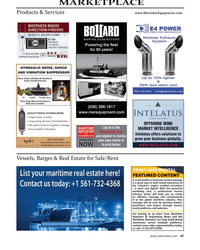 )
April 2024 - Maritime Reporter and Engineering News page: 47
)
April 2024 - Maritime Reporter and Engineering News page: 47MARKETPLACE Products & Services www.MaritimeEquipment.com Powering the fleet for 60 years! HYDRAULIC NOISE, SHOCK AND VIBRATION SUPPRESSOR Noise, Shock, VibraO on & PulsaO on in Quiet, Smooth Flow Out Oil Bladder Nitrogen (blue) Manufactured by MER
-
 )
April 2024 - Maritime Reporter and Engineering News page: 41
)
April 2024 - Maritime Reporter and Engineering News page: 41Nautel provides innovative, industry-leading solutions speci? cally designed for use in harsh maritime environments: • GMDSS/NAVTEX/NAVDAT coastal surveillance and transmission systems • Offshore NDB non-directional radio beacon systems for oil platform, support vessel & wind farm applications
-
 )
April 2024 - Maritime Reporter and Engineering News page: 38
)
April 2024 - Maritime Reporter and Engineering News page: 38Tech Files Latest Products, Systems and Ship Designs Zero-Emission Mooring Service of a Tanker Consulmar achieved a milestone by executing what it calls ing boat Castalia, which operates on full electric propulsion. the world's ? rst zero-emissions mooring service for a tanker. Equipped with two 150 kW
-
 )
April 2024 - Maritime Reporter and Engineering News page: 35
)
April 2024 - Maritime Reporter and Engineering News page: 35SIMULATION e have a close relationship with tech- Realism is prized beyond immersive, photo-realistic visu- nology, evidenced by, for example, als, and providers are introducing increasingly accurate func- the phones we are estimated to un- tionality. FORCE Technology’s upcoming DEN-Mark2 math- lock around
-
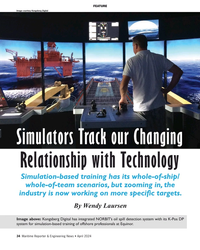 )
April 2024 - Maritime Reporter and Engineering News page: 34
)
April 2024 - Maritime Reporter and Engineering News page: 34FEATURE Image courtesy Kongsberg Digital Simulators Track our Changing Relationship with Technology Simulation-based training has its whole-of-ship/ whole-of-team scenarios, but zooming in, the industry is now working on more speci? c targets. By Wendy Laursen Image above: Kongsberg Digital has integrated
-
 )
April 2024 - Maritime Reporter and Engineering News page: 32
)
April 2024 - Maritime Reporter and Engineering News page: 32FEATURE A closeup of a blade installation process taken via drone. A blade handling system is apparent (in yellow). Images courtesy of Mammoet requirement for the development of these cranes, particularly ling area. This would result in a major time and fuel saving. in ? oating offshore wind,” says
-
 )
April 2024 - Maritime Reporter and Engineering News page: 25
)
April 2024 - Maritime Reporter and Engineering News page: 25RADM PHILIP SOBECK, MILITARY SEALIFT COMMAND Photo by Brian Suriani USN Military Sealift Command From a global supply chain perspective, What makes MSC so vital to the we’ve learned a lot about dealing with Navy’s ? eet and our military disruptions. COVID delivered a big forces around the world? wake-up
-
 )
April 2024 - Maritime Reporter and Engineering News page: 21
)
April 2024 - Maritime Reporter and Engineering News page: 21ROB LANGFORD, VP, GLOBAL OFFSHORE WIND ob Langford has worked in the offshore industry ABS. “We are growing and evolving our services across all for more than three decades, ‘cutting his teeth’ offshore infrastructure along with our continued support to the in a UK design ? rm working in the North Sea
-
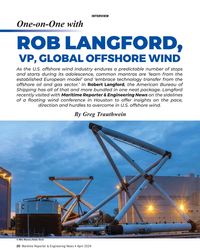 )
April 2024 - Maritime Reporter and Engineering News page: 20
)
April 2024 - Maritime Reporter and Engineering News page: 20INTERVIEW One-on-One with ROB LANGFORD, VP, GLOBAL OFFSHORE WIND As the U.S. offshore wind industry endures a predictable number of stops and starts during its adolescence, common mantras are ‘learn from the established European model’ and ‘embrace technology transfer from the offshore oil and gas
-
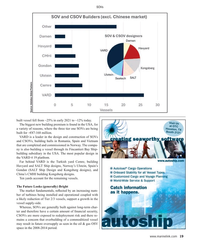 )
April 2024 - Maritime Reporter and Engineering News page: 19
)
April 2024 - Maritime Reporter and Engineering News page: 19SOVs Source: Intelatus Global Partners built vessel fell from ~25% in early 2021 to ~12% today. Visit Us The biggest new building premium is found in the USA, for at OTC Houston, TX a variety of reasons, where the three tier one SOVs are being Booth 2121 built for ~€87-168 million. VARD is a leader in
-
 )
April 2024 - Maritime Reporter and Engineering News page: 18
)
April 2024 - Maritime Reporter and Engineering News page: 18MARKETS & gas activity returns, we anticipate that supply of the vessels The Question of Emissions to offshore wind projects will reduce, driving demand for ad- Given that SOVs and CSOVs operate in a segment target- ditional CSOVs. ing reduced emissions, and many operate in the North Eu- Outside of China
-
 )
April 2024 - Maritime Reporter and Engineering News page: 17
)
April 2024 - Maritime Reporter and Engineering News page: 17SOVs China, we do not look at demand for SOVs/CSOVs as having a linear rela- tionship to the number of wind farms or turbines installed. We look to see where a large number of wind turbines are concentrated in relatively close proximity, generally in a very large wind farm or in a project cluster
-
 )
April 2024 - Maritime Reporter and Engineering News page: 16
)
April 2024 - Maritime Reporter and Engineering News page: 16MARKETS SOVs – Analyzing Current, Future Demand Drivers By Philip Lewis, Director of Research, Intelatus © Björn Wylezich/AdobeStock t a high-level, there are three solutions to transferring Lower day rate CTVs are often used for daily transfer of technicians from shore bases to offshore wind farms
-
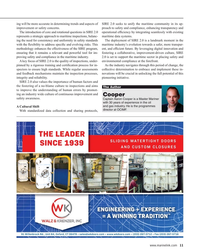 )
April 2024 - Maritime Reporter and Engineering News page: 11
)
April 2024 - Maritime Reporter and Engineering News page: 11ing will be more accurate in determining trends and aspects of SIRE 2.0 seeks to unify the maritime community in its ap- improvement or safety concerns. proach to safety and compliance, enhancing transparency and The introduction of core and rotational questions in SIRE 2.0 operational ef? ciency by
-
 )
April 2024 - Maritime Reporter and Engineering News page: 10
)
April 2024 - Maritime Reporter and Engineering News page: 10Maritime Safety © Roman/AdobeStock SIRE 2.0: Navigating the New Horizon of Maritime Safety By Captain Aaron Cooper, Programs Director, OCIMF he maritime industry is on the cusp of a signi? cant preparing vessel operators and vessel assurance teams for the transformation with the launch of the Ship
-
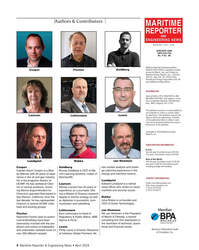 )
April 2024 - Maritime Reporter and Engineering News page: 4
)
April 2024 - Maritime Reporter and Engineering News page: 4Authors & Contributors MARITIME REPORTER AND ENGINEERING NEWS M A R I N E L I N K . C O M ISSN-0025-3448 USPS-016-750 No. 4 Vol. 86 Maritime Reporter/Engineering News (ISSN # 0025-3448) is published monthly Cooper Fischer Goldberg except for March, July, and October by Maritime Activity Reports, Inc.
-
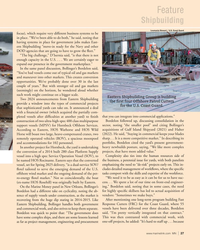 )
April 2024 - Marine News page: 27
)
April 2024 - Marine News page: 27Feature Shipbuilding Loumania Stewart / U.S. Coast Guard focus), which require very different business systems to be in place. “We’ve been able to do both,” he said, noting that having systems in place for government jobs makes East- ern Shipbuilding “move-in ready for the Navy and other DOD agencies
-
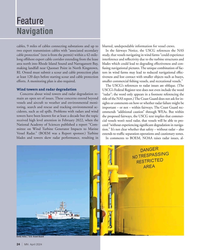 )
April 2024 - Marine News page: 24
)
April 2024 - Marine News page: 24Feature Navigation cables, 9 miles of cables connecting substations and up to blurred, undependable information for vessel crews. two export transmission cables with “associated secondary In the fairways Notice, the USCG references the NAS cable protection” (text is from the permit) within a 42-mile-
-
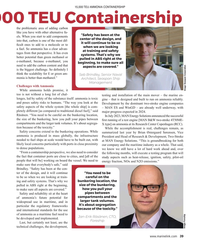 )
February 2024 - Maritime Reporter and Engineering News page: 39
)
February 2024 - Maritime Reporter and Engineering News page: 3915,000 TEU AMMONIA CONTAINERSHIP 000 TEU Containership the problematic area of adding carbon like you have with other alternative fu- “Safety has been at the els. When you start to add components center of the design, and into that, carbon is one of the most dif- it will continue to be so ? cult ones
